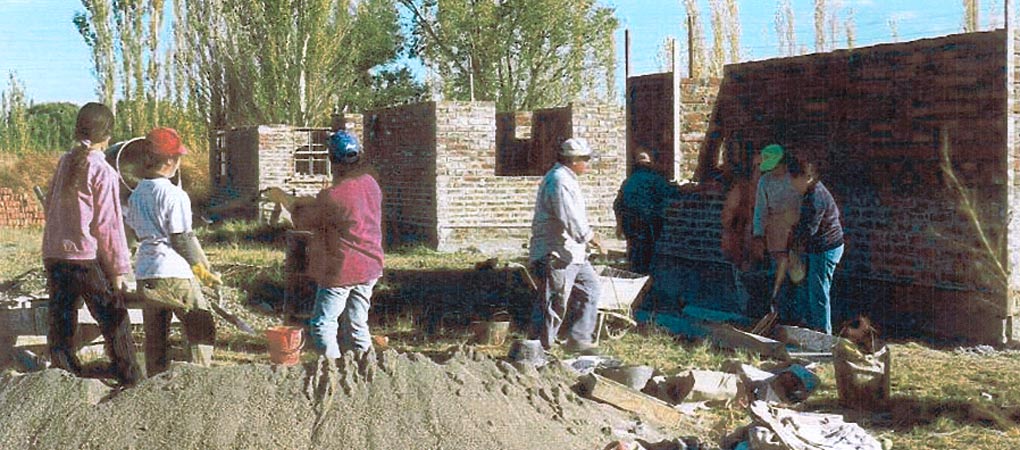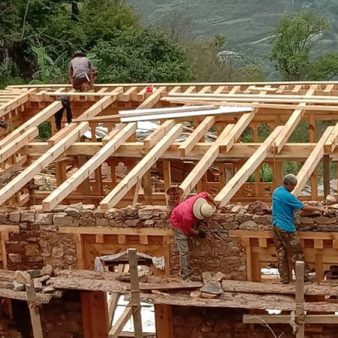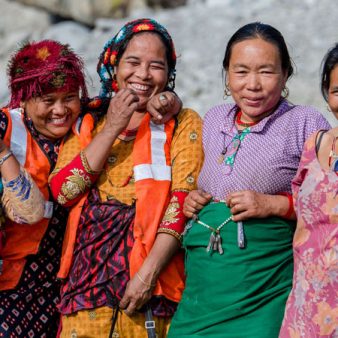The civil society organisation ‘Un Techo para mi Hermano’ has developed a participatory rural housing initiative in partnership with rural workers, students and the local government. Over 500 homes have been built to date through a system of self help and mutual aid, with emphasis placed on building capacity and environmental awareness, as well as strengthening social networks.
Project Description
Aims and Objectives
• To improve housing conditions and quality of life for the rural workers and their families living in conditions of exploitation and exclusion on large rural estates, without jeopardising their jobs.
• To strengthen social networks by developing an integrated and cooperative approach towards construction and management.
• To raise awareness of environmental issues amongst the rural community.
Valle Azul (‘Blue Valley’) is a remote rural area located on the south bank of the Río Negro River in Patagonia which, prior to the 1990s, lacked basic infrastructure, access roads and services. In 2000, a bridge was built over the river, which greatly improved accessibility to the area and led to an increase in agricultural production. Large plantations and cattle ranches in the area are owned by a handful of wealthy landowners, and rural families in the region work in exploitative, near-slavery conditions, with high rates of dependency and little or no possibility of leaving or improving their living environment. Most rural workers in the region live on their employers’ land and are therefore subjected to longer working hours than those fixed by their employment contract. Housing conditions are overcrowded and inadequate; houses are built with pieces of metal or wood and lack proper lighting, ventilation, water supply, sewerage and electricity.
The Hábitat y Desarrollo Rural en Valle Azul project was started by Un Techo para Mi Hermano, a civil society organisation that works with the most vulnerable groups in the Valle Azul area, many of whom are unemployed or work as day labourers, domestic servants or seasonal rural workers. The organisation works in the Patagonia region of Argentina, providing technical assistance to rural families who are building
their homes through a self-help/mutual aid process. To date, 528 families from the region have benefited from the work of the organisation, including the 106 families participating in the ‘Hábitat y Desarrollo Rural en Valle Azul’ project. The work of Un Techo involves capacity building through the development of organisation and self-management skills.
The project involves the collective construction of new homes as well as environmental improvements to the area, including the creation of green areas, reforestation of native species and the replacement of open latrines with new bathrooms and kitchens. The main groups benefiting from the Valle Azul project are low-income rural workers from the communities of ‘Ruca Peñi’ (48 households), ‘Effort and Freedom’ (16 households) and ‘Solidarity and Hope’ (20 households). An additional 22 rural families are currently working on improving their homes and the resulting environmental improvements have benefited the wider community. As the population of the community is growing, the organisation is developing a proposal for the construction of 32 new homes.
This participatory rural housing initiative involved partnerships among low-income rural workers, Un Techo, local and national government and students. The project originally received financial support from two international donor agencies, Deswos and Misereor. In 1996 the project was adopted into the national housing programme and began to receive funding from both the state and the national governments for the purchase of land, provision of infrastructure, community facilities and the plantation of woodlands. Un Techo provided technical assistance and training to community members, who contributed to the project with the construction of homes, newly acquired technical knowledge and skills, resource administration and management, decision-making and community development. Women have played a key role in the process, taking active responsibility for the development of the community.
Through the system of mutual aid, all members of the community work together to build the homes, which are not allocated to individual households until all homes are completed. This approach, along with the discussions and workshops carried out with the community, helps to foster a spirit of cooperation. All residents participate in decision-making on issues affecting the community, taking action toward reforestation and the creation of green spaces, raising awareness of environmental issues, assisting vulnerable members of the community with documentation and other services including creating a community library.
There has been a dramatic improvement in housing conditions and quality of life of rural workers. The new homes provide adequate lighting and ventilation as well as water supply, sewerage and electricity and have been built with solid materials, in contrast to the previous housing conditions of the rural families. Training and experience in self-management has led to increased levels of confidence and involvement in decision-making processes, particularly among women.
Households that were previously scattered throughout the valley have now formed a consolidated rural community with a stable population and very low rates of unemployment. Contrary to what is happening in most rural areas in the country, where the population is emigrating to large urban centres seeking better life conditions, a stable rural community has been established in the valley over the last 10 years. Whilst the unemployment index in Argentina is around 15 per cent for the economically active population, Valle Azul has an unemployment rate of only one per cent.
The project relies on a combination of funding from the national government and international donor agencies. The Ministry of Infrastructure and Housing is funding the current PROPASA home improvement programme.
The total capital costs for the 84 new-build homes came to $382,605, including materials ($158,537), technical assistance ($19,653), administrative costs ($4,126), quantitative labour costs for mutual aid ($63,414) and land ($136,875). Rural households contributed their labour and repaid 15 per cent of the cost of materials (ca. $23,780, or an average of $280 per family) into a common fund to guarantee the continuity of the programme. The final cost of the new homes is less than 50 per cent of the cost of houses built by construction firms contracted by the state.
Why is it innovative?
- Introduction of a participatory, mutual aid housing process in remote rural areas.
- Active participation of women during all stages of the project, including construction and decision-making.
- Strengthening of formerly excluded groups and empowerment of residents to take a more active role in society.
- Development of sustainable rural communities, improving the living conditions of rural families who do not wish to move to the city and live in urban shantytowns.
- Reversal of the rural-urban migration process.
What is the environmental impact?
The project provides water and urban infrastructure where there previously was none whilst the improved ventilation and lighting contribute toward the rational use of energy and water resources. Wider environmental improvements to the area include the creation of green areas as well as the creation of a tree nursery to reproduce native species for reforestation of the valley.
Is it financially sustainable?
The programme enabled poor rural families, who lacked the means to build their own homes and were excluded from government housing programmes, to improve their living conditions through access to land, technical assistance and building materials. Families contributed their labour through mutual aid construction, thus keeping costs down.
What is the social impact?
The organisation specifically targets the most vulnerable sectors of the population and works toward the reduction of social inequalities. The project has empowered socially excluded rural workers to break away from exploitation and dependency and take an active role in the improvement of their living and working conditions. The development of the capacity for self-management has given rise to social change, arising from the people’s capacity to transform their own living conditions through self-help, mutual collaboration and organisation. Women in particular have been empowered, and there has been increased participation by community members at the local government level and influence at the provincial level.
Barriers
- An initial lack of commitment and reluctance to take on group responsibility was overcome through engaging the community in regular meetings with technical staff.
- The project was unable to continue on a larger scale due to a lack of funding.
Lessons Learned
- Through the creation of a consolidated rural village/community, it is possible to change the exploitative conditions of rural households living at their place of work, whilst protecting their jobs.
- A participatory mutual aid process can provide a positive contribution toward resolving the rural housing problem.
- Rural workers deserve decent living conditions and there is an increased awareness of these issues amongst civil society.
Evaluation
An independent evaluation of the programmes assisted by Un Techo was carried out by the National University of Comahue, using a participatory method of ‘self-evaluation’ in which the residents themselves were actively involved in the monitoring and evaluation process in partnership with the university. The positive impact of the mutual aid process on the community as well as aspects of the project such as economy of resources, environmental awareness and strengthened social networks were contrasted with state housing programmes and highlighted in the policy recommendations made as a result of the study.
Transfer
The experience of the initial group of 48 families led to requests from other groups in the region and the transfer of the project to the ‘Effort and Freedom’ community (16 households), the ‘Solidarity and Hope’ community (20 households) and the 22 rural families that are currently working on improving their homes.
Elements of the project, particularly its approach and methodology, have been taken up by other NGOs at provincial and national level as a result of national workshops and seminars in which the experience has been presented.
The experience has informed national policy, placing the rural housing problem as a priority on the government agenda and contributing toward the formulation of current Housing Improvement Programmes, which consider participatory processes and mutual help housing construction in small groups to be an effective way of resolving the housing needs of the rural population.
Partnership
NGO, CBO, Local Government, National Government



